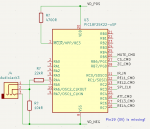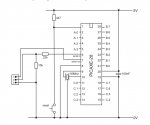Hi there!
I am designing a PCB for a fully tested circuit. I found an EDA Symbol for the PICAXE chip, or at least I thought I could use the Microchip PIC18F25K22-xSP Symbol (below). However - after completing all other parts of the circuit I just noticed that pin 19 is missing! Does anybody know why? Is Pin 19 tied to Pin 8 internally?

My (fully functioning) prototype is implemented as per Picaxe Manual1 page 35, including 0V connection to pins 8 and 19.

Why would the microchip Symbol have deleted pin 19??
Thanks!!!
Popchops.
I am designing a PCB for a fully tested circuit. I found an EDA Symbol for the PICAXE chip, or at least I thought I could use the Microchip PIC18F25K22-xSP Symbol (below). However - after completing all other parts of the circuit I just noticed that pin 19 is missing! Does anybody know why? Is Pin 19 tied to Pin 8 internally?

My (fully functioning) prototype is implemented as per Picaxe Manual1 page 35, including 0V connection to pins 8 and 19.

Why would the microchip Symbol have deleted pin 19??
Thanks!!!
Popchops.
